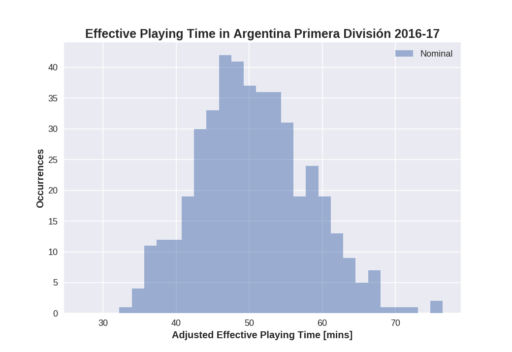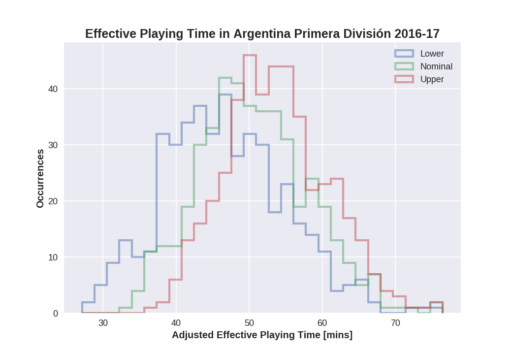A final review of effective playing time in Argentina’s 2016-17 Primera
Categories: Match Quality Metrics
Last night, I tweeted a teaser for this post that said that the median effective playing time in Argentina’s Primera División matches is in the vicinity of 48 minutes, which is very low for a domestic football competition:
Por mis cálculos, la mediana del tiempo efectivo de juego en 1ra División Argentina 16/17 se queda alrededor de 48′.
Más detalles mañana— Soccermetrics (@soccermetrics) July 12, 2017
The reality is that my calculated estimate is closer to 50 minutes than 48, which doesn’t sound like much but is actually a 4% difference, which is a big enough difference for me.
In most cases, I can calculate the exact effective playing time from match event data if ball out events — those events that prompt a restart with a throw-in — are properly recorded. Unfortunately, DataFactory does not record such events, so I have to estimate the amount of time lost from the number of throw-ins made. (This is not a knock on DataFactory; their data set is for a different market than other data suppliers.) The uncertainty range in the regression coefficients defines the minimum and maximum ranges of time lost. This post from 2014 explains the estimation procedure as applied to the World Cup.
What has made the effective time calculations even more complicated for Primera División Argentina 2016-17 is that for several matches, no throw-in events were recorded in a single period by DataFactory. This meant among other things that no time was lost due to throw-ins which also meant that the resulting effective time for those matches was close to 75 or 80 minutes. The lack of throw-ins in a match is something that I find highly unlikely, so these matches have been excluded from the data set. For those of you wondering, these matches are:
- Rosario Central vs Colón de Santa Fe (no throw-ins in 2nd half)
- Unión de Santa Fe vs Arsenal de Sarandí (no throw-ins in either half)
- Boca Juniors vs Newell’s Old Boys (no throw-ins in 2nd half)
- Huracán vs Unión de Santa Fe (no throw-ins in 2nd half)
There are other matches with less than 10 throw-ins in a single period, but I’ve decided to keep these matches in the data set.
In the end, the distribution of effective playing time in Primera looks like the figure below. The horizontal axis represents the nominal amount of effective playing time, and the vertical axis represents the number of occurrences in the championship.
The median effective playing time for the competition was 50 minutes 7 seconds, from a low of 32 minutes 41 seconds (Olimpo vs Atlético Rafaela) to a high of 70 minutes 42 seconds (Olimpo vs San Lorenzo). It’s quite uncommon for a team’s home matches to feature the highest and lowest amounts of effective match time. Olimpo’s matches tend to occupy the lower regions of the effective match time table.
Here is how the upper and lower bound estimates of effective time look:
If you account for the loss of playing time due to throw-ins, the effective playing time for a typical match in Argentina’s Primera División is somewhere between 46 and 53 minutes, which is well below the typical amount of playing time for domestic competitions such as the English Premier League or Japan’s J-League or international competitions like the FIFA World Cup finals.
In a future post, I’ll look at the sources of playing time lost and the effects of the teams on the differences in effective playing time.



